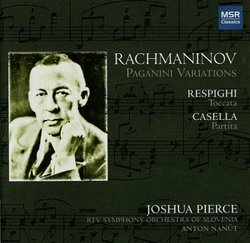| All Artists: Rachmaninov; Respighi; Casella, Anton Nanut, RTV Symphony of Slovenia, Joshua Pierce (piano) Title: Rachmaninov: Paganini Variations; Respighi & Casella Members Wishing: 0 Total Copies: 0 Label: MSR Classics Original Release Date: 1/1/2006 Re-Release Date: 3/7/2006 Genre: Classical Styles: Forms & Genres, Concertos, Instruments, Keyboard, Symphonies Number of Discs: 1 SwapaCD Credits: 1 UPC: 681585117620 |
Search - Rachmaninov; Respighi; Casella, Anton Nanut, RTV Symphony of Slovenia :: Rachmaninov: Paganini Variations; Respighi & Casella
 | Rachmaninov; Respighi; Casella, Anton Nanut, RTV Symphony of Slovenia Rachmaninov: Paganini Variations; Respighi & Casella Genre: Classical
THE ITALIAN CONNECTION. Here are three seemingly disparate works: one influential in its day, another long forgotten and a third, one of the best-known and best-loved works of its kind. Yet, in spite of the many difference... more » |
Larger Image |
CD Details
Synopsis
Product Description
THE ITALIAN CONNECTION. Here are three seemingly disparate works: one influential in its day, another long forgotten and a third, one of the best-known and best-loved works of its kind. Yet, in spite of the many differences in origin and musical between these two Italians and a pianist/composer from Russia, there are many lines of connection. They are all non-standard concerted works for piano and orchestra and all three were written as vehicles for the composers themselves to play on tour in the United States. Two had their premieres in Carnegie Hall with the New York Philharmonic; the other first appeared in Baltimore with the touring Philadelphia Orchestra and also turned up at Carnegie not very long thereafter. There are other, deeper connections. All are modernist pieces with strong connections to tradition. And there is even a connection between the revival of Italian instrumental music in the early twentieth century and the evolution of Russian music. The classical tradition was, of course, originally Italian; Italian instrumental music held its own until the 19th century when it was overwhelmed by opera. Italian classicism was well established in Russia in the 18th century. Paesiello wrote his once-famous ?Barber of Seville? for the court opera of St. Petersburg, a town built in pure classical style by an Italian. A century and a quarter afterwards, Igor Stravinsky did a take on the Italian 18th century for Diaghilev?s Russian Ballet in Paris; ?Pulcinella,? inspired by commedia dell?arte and Pergolesi, marks the beginning of musical neo-classicism. All the works on this album can be regarded as neo-classical. Even Stravinsky?s arch-rival and nemesis, the ultra-Romantic Sergei Rachmaninov, eventually succumbed to the lure of Pulcinella, the commedia dell?arte and Italian classicism.

 Track Listings (28) - Disc #1
Track Listings (28) - Disc #1